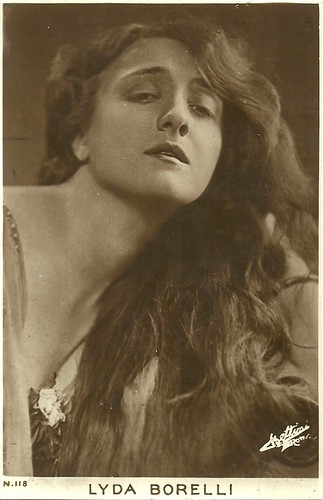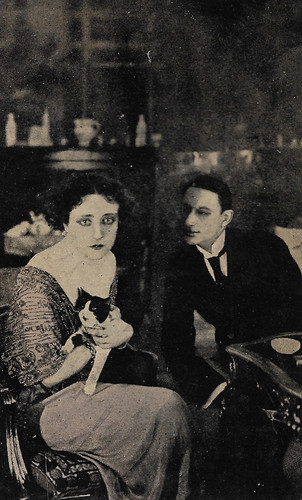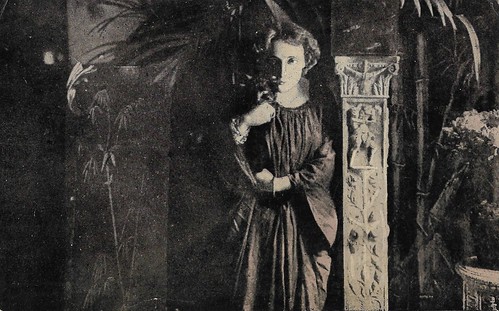
Italian postcard by Ed. Soc. Anon. Bettini, Roma, no. 173. Photo: Riccardo Bettini. Lyda Borelli.

Italian postcard by Ed. Soc. Anon. Bettini, Roma, no. 118. Photo: Riccardo Bettini. Lyda Borelli.

Italian postcard by Ed. Soc. Anon. Bettini, Roma, no. 275. Photo: Riccardo Bettini. Pietro Mascagni.

Italian postcard by Ed. Soc. Anon. Bettini, Roma, no. 158. Photo: Riccardo Bettini. Lyda Borelli.

Italian postcard by Ed. Soc. Anon. Bettini, Roma, no. 164. Photo: Riccardo Bettini. Lyda Borelli.
Additional footage, shot to please the maestro
Rapsodia Satanica/Satan's Rhapsody (1917) was at the time called "a cinematographic poem". This poetic vein can be found in the film's intertitles. The poet Fausto Maria Martini wrote the story of the film, in verse, in collaboration with the director of the Cines, Baron Alberto Fassini, who used the pseudonym Alfa. The old Contessa Alba d'Oltrevita (Lyda Borelli) deplores her faded youth after a party at her castle. Mephisto (Ugo Bazzini) steps out of a painting and offers her a pact: if she denies love, he will make her young again. She destroys a statuette of Love to confirm her renouncement (yet, the sculpture was not entirely broken). Alba changes into youthful splendour and enjoys the company of young men, in particular the two brothers Tristano (André Habay a.k.a. Andrea Habay) and Sergio (Giovanni Cini). Sergio is head over heels in love with her, but she laughs him off.
During a costumed ball, in which Alba is dressed as Salome, she gets a note from Sergio, telling her to come out at midnight or he will kill himself. The capricious Alba then seduces Tristano and forces him to choose: either he or his brother will have her. He goes mad and prevents her from going outside. A shot is heard: Sergio has killed himself. Tristano and Alba are shocked, she pushes him away and closes the castle to mourn her loss. After a while she notices Spring has arrived and revives, covering her rooms with flowers. At nighttime, she notices there is a cavalier on the hills. Could it be Tristano returning? She dresses up like a priestess and goes outside, expecting her lover. But instead, it is Mephisto who punishes her for falling in love and changes her back into the old lady. When she sees herself in the pond, she dies of a heart attack.
As Anthony Kobal writes on IMDb, "Rapsodia satanica was the last film directed by Nino Oxilia and is undoubtedly one of the finest achievements of the early Italian cinema. In it, Oxilia spins a variation on the Faust myth, embodied here by the diva Lyda Borelli. Typical of extravagant D'Annunzian aestheticism at its height, Rapsodia Satanica was one of the summits of what was later called the 'tail coat film'. Diametrically opposed to the "cinema of reality" practised by Serena, Martoglio and others, 'tail coat films' set their melodramatic stories in the salons and villas of the upper middle class and the aristocracy, deploying narrative structures contrived to showcase their actors and especially its actresses. This had the effect of accentuating their physical presence and turning them into stars - probably the first stars in movie history. The success of the "diva" contributed to the development of motion picture grammar in its special use of the close-up."
Rapsodia satanica (Nino Oxilia, 1917) was the first and only film to feature a score written especially for it by famous Italian composer Pietro Mascagni (1863-1945) primarily known for his operas. His masterpiece 'Cavalleria rusticana' (1890) caused one of the greatest sensations in opera history and single-handedly ushered in the Verismo movement in Italian dramatic music. Mascagni wrote fifteen operas, an operetta, several orchestral and vocal works, and also songs and piano music. Pietro Mascagni was probably the first composer to write a full score for an Italian feature film. Director Nino Oxilia had started shooting the film already in 1914. In 1915, Mascagni signed an exclusive contract with Cines to compose music for a film. Originally, Mascagni was to write a score for a film based on the life of Giuseppe Garibaldi, but the scenario by the socialist parliamentarian Enrico Ferri turned out to be too boring, too historical and, according to Mascagni, lacked lyricism. The project was cancelled. After that, three films were presented to Mascagni, of which Mascagni selected Rapsodia satanica, but under various conditions. The main condition was that the last part be entirely refilmed. Oxilia filmed additional footage shot to please the maestro.
Rapsodia satanica was ready in 1915. The film was presented for the press at the Augusteo in Rome and enthusiastically acclaimed by the critics. For reasons unknown, the film did not receive a censorship visa until June 1917. The official premiere took place on 5 July 1917, again at the Augusteo, but in the middle of Summer: audiences and critics had gone on holiday. More than sixty years later, in the 1980s the film was rediscovered. In the Netherlands, the film was included in the retrospective Hartstocht en heldendom: Il primo cinema italiano, 1905-1945 (1988), co-organised by Ivo Blom and Nelly Voorhuis. Only a black-and-white version was available at the time. In 1996, a part monochrome tinted and toned, and part hand-coloured version was found at the Cinémathèque Suisse in Lausanne. Thanks to the film archives of Bologna, Milan and Lausanne the film was analogue restored. In 2015 the film was digitally restored in 4K by Bologna and Lausanne. In 2018 Cineteca di Bologna released the 4-films-DVD Dive!, which includes Rapsodia satanica, with the music by Pietro Mascagni.

Spanish cromo by Chocolate Pi, Barcelona, no. 1 of 6 cards. Photo: Cines / J. Muntañola. Lyda Borelli and Ugo Bazzini in Rapsodia satanica (Nino Oxilia, 1917).

Spanish cromo by Chocolate Pi, Barcelona, no. 2 of 6 cards. Photo: Cines / J. Muntañola. Lyda Borelli, Giovanni Cini and Andrea Habay in Rapsodia satanica (Nino Oxilia, 1917).

Spanish cromo by Chocolate Pi, Barcelona, no. 3 of 6 cards. Photo: Cines / J. Muntañola. Lyda Borelli and Giovanni Cini in Rapsodia satanica (Nino Oxilia, 1917).

Spanish cromo by Chocolate Pi, Barcelona, no. 4 of 6 cards. Photo: Cines / J. Muntañola. Lyda Borelli and Giovanni Cini in Rapsodia satanica (Nino Oxilia, 1917).

Spanish cromo by Chocolate Pi, Barcelona, no. 5 of 6 cards. Photo: Cines / J. Muntañola. Lyda Borelli, Giovanni Cini and Andrea Habay in Rapsodia satanica (Nino Oxilia, 1917).

Spanish cromo by Chocolate Pi, Barcelona, no. 6 of 6 cards. Photo: Cines / J. Muntañola. Lyda Borelli in Rapsodia satanica (Nino Oxilia, 1917).
Sources: Le giornate del cinema muto (Italian), Ivo Blom ('Rapsodia satanica', catalogue festival Cinemémoire (1991)), Cinema Ritrovato catalogues 1996 and 2015, Wikipedia (Italian and English) and IMDb.
No comments:
Post a Comment